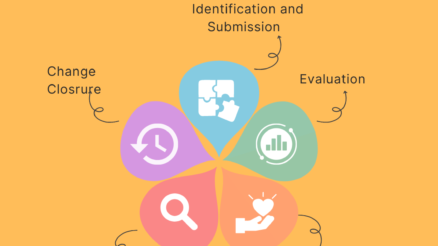Change is coming to modern day workplace at fast pace.
From technological advancements to organizational shifts and cultural changes, organizations must adapt and evolve to become agile, stay competitive and meet the needs of their employees and stakeholders.
These are some examples of change in the workplace that are very common. By understanding the various forms of change that can occur in the workplace, organizations can be better prepared to navigate them and achieve impactful results of change.
In this blog post, we’ll discuss three broad categories of changes and under each categories there are specific real-world examples of change. These three categories are: technological, organizational and cultural change. Overall, each type of change has a different scope and focus, and it is important for organizations to understand the different types of change and how they can be implemented effectively.
Let’s discuss each of these in detail.
1. Technological changes
Technological change refers to the introduction of new technology or the adoption of new technology in the workplace. Such changes are made to improve efficiency and reduce costs. Following are some examples of technological changes.
1.1 Automation of tasks
Automation of tasks is a technological change that refers to the use of technology to perform tasks that were previously done by humans. This can include tasks such as data entry, scheduling, and even more complex processes such as customer service interactions and financial analysis. Automation is made possible through the use of software, such as robotic process automation (RPA) and artificial intelligence (AI).
Automation can speed up repetitive and routine tasks, freeing up employees to focus on more strategic and value-adding activities. Additionally, automation can also improve accuracy and consistency, as machines do not make mistakes as often as humans.
However, automation also has some potential drawbacks. One of the main concerns is job displacement. As machines take over certain tasks, it can lead to the loss of jobs for employees who previously performed those tasks. Another potential issue is that automation may require a significant initial investment, and it may be difficult to achieve a positive return on that investment.
1.2 Adoption of new software and tools
Adoption of new software and tools is another example of technological change in the workplace. These tools and software can range from standard office productivity tools like word processors and spreadsheets, to more specialized software such as customer relationship management (CRM) systems, project management tools, and cloud-based collaboration platforms.
One of the main benefits of adopting new software and tools is increased productivity and efficiency. For example, a CRM system can help sales teams manage customer interactions more effectively, and project management software can help teams collaborate more easily and stay organized. Additionally, cloud-based platforms can make it easier for employees to work remotely, which can have a positive impact on work-life balance.
However, adoption of new software and tools can also bring some challenges. One of the main challenges is the learning curve associated with using new software and tools. Employees may need to spend time and effort learning how to use new tools, which can be disruptive to their workflow. Additionally, it is important to make sure that new software and tools integrate well with existing systems and that they are supported by the organization.
1.3 Remote work and virtual collaboration
Remote work and virtual collaboration are a form of technological change in the workplace, enabled by the widespread availability of high-speed internet and mobile devices. Remote work refers to the ability for employees to work from anywhere, outside of a traditional office setting, while virtual collaboration refers to the use of technology to enable remote teams to work together effectively.
One of the main benefits of remote work and virtual collaboration is increased flexibility for employees. With remote work, employees have more freedom to choose where they work, which can have a positive impact on their work-life balance. Virtual collaboration tools such as video conferencing, instant messaging, and cloud-based file sharing can make it easier for remote teams to stay connected and communicate effectively. This can lead to increased productivity, improved employee engagement, and greater access to a diverse workforce.
However, remote work and virtual collaboration also have potential drawbacks. One of the main challenges is the lack of face-to-face interaction and the potential for isolation. Remote workers may also find it harder to build personal connections with their colleagues and managers. Additionally, there are also issues of technology and internet connectivity which could hinder productivity and communication.
2. Organizational changes
Organizational change refers to changes in the way the organization is structured, managed, and operated. The main goal of organizational change is to improve the efficiency and effectiveness of the organization. Following are some examples of organizational changes.
2.1 Restructuring and re-organization
Restructuring and re-organization are examples of organizational changes that can occur in the workplace. These changes typically involve changes to the company’s internal structure, including changes to the reporting hierarchy, roles and responsibilities, and the overall way that work is done.
The main goal of restructuring and re-organization is to improve efficiency and effectiveness of the organization. It may involve streamlining departments, eliminating redundant positions, and consolidating functions. For example, a company may restructure to create cross-functional teams to promote collaboration and knowledge-sharing among different departments. Additionally, a company may re-organize to better align its structure with its overall business strategy and goals.
Restructuring and re-organization can bring many benefits to the organization. It can improve efficiency and effectiveness by eliminating bottlenecks, reducing duplication of efforts and making better use of resources. It can also lead to greater flexibility and agility, allowing the company to respond more quickly to changes in the market.
However, restructuring and re-organization can also be disruptive to the organization and its employees. It can lead to job loss, uncertainty and confusion among employees, as well as a loss of morale and motivation. It is also important to note that change in organizational structure can take a lot of time, effort, and resources, and it’s also important to communicate the reasons for change and its benefits effectively to the employees.
2.2 Mergers and acquisitions
Mergers and acquisitions (M&A) are a form of organizational change that involve the joining of two or more companies to form a new entity. In a merger, two companies combine to form a single new entity, while in an acquisition, one company takes over the ownership of another company.
The main goal of M&A is to create synergies, by combining resources, knowledge, and skills to create a more competitive and profitable organization. Mergers can allow companies to expand their market share, enter new markets, or reduce competition. Acquisitions can enable companies to gain access to new technologies, products, or talent, or to eliminate a potential competitor.
M&A can bring many benefits to the organization, such as cost savings by eliminating redundancies, increasing market share, expanding into new markets and gaining access to new technologies and products. They can also provide access to new talent, new customers and the opportunity to increase the scale of operation.
However, M&A can also be a very complex and difficult process. It can be stressful for employees, customers, and other stakeholders as it can lead to job loss, uncertainty and confusion among employees, and a loss of morale and motivation. Furthermore, cultural incompatibilities can arise when two companies with different cultures and practices merge together. It’s important for organizations to have a clear communication strategy, and for them to be transparent about the reasons for the merger or acquisition and its benefits.
2.3 Changes in leadership and management
Changes in leadership and management refer to the replacement or reassignment of leaders and managers within an organization. This can include changes in top management, such as the CEO or COO, as well as changes at lower levels of management, such as department heads or team leaders.
The main goal of changes in leadership and management is to improve the effectiveness and efficiency of the organization. A change in leadership can bring fresh perspective and new ideas to an organization, and can also provide the opportunity for new direction or refocus on specific goals. New management can bring new strategies, new management styles and new ways of doing things.
Changes in leadership and management can bring many benefits to the organization, such as an infusion of fresh ideas and new energy, which can help to revitalize an organization and make it more competitive. New leadership can also bring about a renewed focus on the company’s mission and goals, which can lead to greater efficiency and productivity.
However, changes in leadership and management can also be disruptive to the organization and its employees. It can lead to uncertainty and confusion among employees, as well as a loss of morale and motivation. Moreover, new leaders may not be familiar with the organization’s culture, history and the way things have been done, which can lead to resistance to change.
2.4 Shift towards flat or decentralized structures
A shift towards flat or decentralized structures is an organizational change that refers to the move from a hierarchical, top-down organizational structure to a flatter, more decentralized structure. In a flat structure, there are fewer levels of management and decision-making authority is distributed more widely throughout the organization. In a decentralized structure, decision-making is shifted away from the central headquarters to individual departments or business units.
The main goal of a shift towards flat or decentralized structures is to increase flexibility, speed, and innovation within the organization. A flatter structure can lead to more efficient and effective communication and decision-making, as well as greater empowerment for employees at all levels of the organization. A decentralized structure can also enable the organization to respond more quickly to changes in the market, as decisions can be made closer to the source of the problem or opportunity.
A flat or decentralized structure can bring many benefits to the organization. It can create more opportunities for employee empowerment, increased flexibility and speed in decision-making, and more efficient communication. It also can lead to a more agile and adaptive organization and can increase motivation, creativity and innovation.
However, a shift towards flat or decentralized structures also has some potential drawbacks. One of the main concerns is that it can lead to confusion and lack of direction, and it can also lead to conflict and duplication of effort. Moreover, it can also make it harder to achieve a consistent corporate culture.
3. Cultural changes
Cultural change refers to changes in the way that work is done, and how employees interact and engage with each other. Examples of cultural change can include changes in company values and mission, changes in leadership style, and the implementation of new policies and procedures. The main goal of cultural change is to create a more positive and productive organizational culture.
3.1 Diversity, equity, and inclusion initiatives
Diversity, equity, and inclusion initiatives are cultural changes that organizations can implement to promote a more inclusive and equitable workplace for all employees. Diversity refers to the representation of people from different backgrounds and identities in an organization. Equity refers to the fair and just distribution of resources and opportunities. Inclusion refers to creating a culture where all employees feel valued, respected and have a sense of belonging.
The main goal of diversity, equity, and inclusion initiatives is to create a more inclusive and equitable workplace for all employees, regardless of their background or identity. These initiatives can include policies, programs and practices that promote diversity, equity and inclusion, such as:
- Recruitment and hiring initiatives that aim to attract and retain a diverse workforce.
- Employee resource groups (ERGs) to provide support and resources to employees from underrepresented groups
- Training and education programs that raise awareness of unconscious bias and promote inclusivity
- Diversity and inclusion metrics to measure progress and identify areas for improvement
Diversity, equity, and inclusion initiatives can bring many benefits to the organization. A diverse workforce can bring a wider range of perspectives, ideas and talents, which can lead to increased innovation, creativity and competitiveness. Inclusion can help to create a culture where employees feel valued, respected, and have a sense of belonging. This can lead to improved employee engagement, motivation and retention.
However, implementing diversity, equity, and inclusion initiatives can be challenging. It requires a long-term commitment, change in leadership mindset, employee engagement and a willingness to be held accountable for progress. These initiatives can also be costly, but it is important to see them as an investment in the organization’s future.
3.2 Changes in company values and mission
Changes in company values and mission refer to modifications to an organization’s fundamental beliefs and objectives. This can include changes to the company’s overall purpose, vision, or goals, as well as changes to the company’s values and principles.
The main goal of changes in company values and mission is to align the organization’s culture and actions with its fundamental beliefs and objectives. This can help to create a sense of purpose and direction for employees, and can also help to attract and retain employees who share the company’s values and mission. Additionally, changes in company values and mission can help to signal a renewed focus or direction for the organization, and can also be used to signal a change in leadership or direction for the company.
Changes in company values and mission can bring many benefits to the organization, such as:
- An aligned culture and actions with the company’s values and mission
- Greater employee engagement and motivation
- A renewed sense of direction and purpose for the organization
- Improved reputation and ability to attract and retain employees
However, making changes to a company’s values and mission can be a complex process and can be disruptive to the organization and its employees. It requires a thorough understanding of the company’s culture and history, and it should be communicated and implemented with care to make sure it is understood and embraced by the employees.
Furthermore, it’s important to ensure that the changes align with the company’s goals and that the employees understand and buy in to the new values and mission.
3.3 Implementation of new policies and procedures
Implementation of new policies and procedures is a cultural change that refers to the introduction of new rules and guidelines that govern how work is done within an organization. These policies and procedures can cover a wide range of topics, such as employee conduct, performance management, safety, and data protection, among others.
The main goal of implementing new policies and procedures is to create a more efficient and effective workplace, while also promoting a positive organizational culture. These policies and procedures can help to create a framework that guides employee behavior, and can also help to promote a culture of accountability and responsibility within the organization. Additionally, policies can also help to ensure that employees are aware of the expectations and behaviors that are expected of them, and what is acceptable in the workplace.
Implementation of new policies and procedures can bring many benefits to the organization, such as: more efficient and effective workplace, greater accountability and responsibility among employees. Improved compliance with legal and regulatory requirements and a stronger organizational culture.
However, implementing new policies and procedures can also be challenging. It requires careful planning and communication to ensure that employees understand the new policies and procedures, and it can also lead to confusion and resistance among employees if they are not communicated effectively. It’s important to provide training and resources that help employees understand how to comply with the new policies and procedures, and to ensure that they align with the company’s values and culture.
Final Words
Change is a constant in the workplace, and it can take many forms such as technological, organizational, and cultural change. Under these categories there are many examples of change in the workplace. Organizations need to approach each type of change thoughtfully and carefully, considering the potential impact on employees and the organization as a whole. Finally, it’s essential for organizations to continuously strive for improvement, adaptability and alignment with their environment, mission and values.



